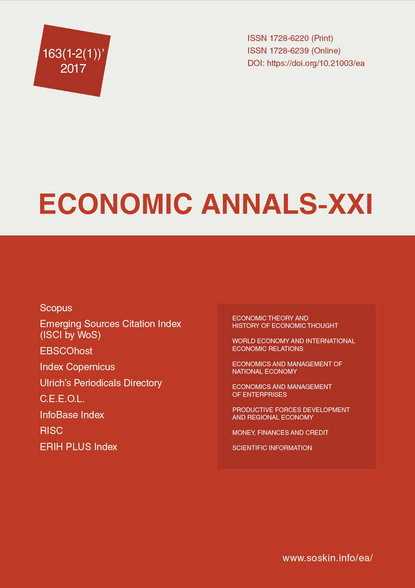Analytical tools to implement integrated bank financial management technologies
Analytical tools to implement integrated bank financial management technologies
Author(s): Iryna Chmutova, Viktoriia Vovk, Olena BezrodnaSubject(s): Economy, Financial Markets
Published by: Institute of Society Transformation
Keywords: Bank; Financial Management Technologies; Balanced Scorecard; Benchmarking; Financial Controlling
Summary/Abstract: Introduction. The rapid development of bank financial management technologies prompted by the increasing sophistication and scaling of control elements calls for harmonisation of its functions and improved analytical support. The purpose of the paper is to develop analytical tools to implement integrated bank financial management technologies, such as the balanced scorecard, benchmarking and financial controlling, which would factor in all the stages of the bank’s life cycle. The study employed the following methods: logical synthesis - to form a system of performance indicators to measure the bank’s financial results, customer base, business processes and human resources management; canonical analysis - to establish the cause and effect relationships between the indicators. Results. Based on the example of 27 Ukrainian banks at the intensive growth stage as a case study, the paper proves close correlation between the perspectives of the balanced scorecard: «Personnel Development»- «Business Processes»; «Business Processes» - «Customers»; «Customers» - «Finances». Conclusions. The proposed set of analytical tools allows observing the specifics of the cause and effect relationships at each stage of the bank’s life cycle between its performance indicators of financial results, customer base, business processes and personnel management. It constitutes grounds for the adjustment of the bank’s objectives maps with due regard to the cyclic nature of its development, as well as for the creation of mechanisms to apply the balanced scorecard, benchmarking and financial controlling technologies. It is advisable to employ indicators with the closest correlation in benchmarking for setting targets when doing financial planning (using the indicators of the reference bank for this purpose), and when realising financial controlling - to find deviations of the controlled indicators from the planned figures as well as develop recommendations to eliminate the causes of such deviations. According to the results of our research, these indicators were found: for the perspective «Finances» - the total capital adequacy ratio and the share of retail loans in assets; for the perspective «Customers» - the average liabilities per one customer and the expenditure per one customer; for the perspective «Business Processes» - the operating expenditure in the total expenditure, the revenues from new products in the bank’s total revenue and the share of new products in the product line; for the perspective «Personnel Development» - the intellectual potential factor and the share of employees with higher education in the total number of personnel.
Journal: Економічний часопис - ХХІ
- Issue Year: 163/2017
- Issue No: 01+02
- Page Range: 95-99
- Page Count: 5
- Language: English

